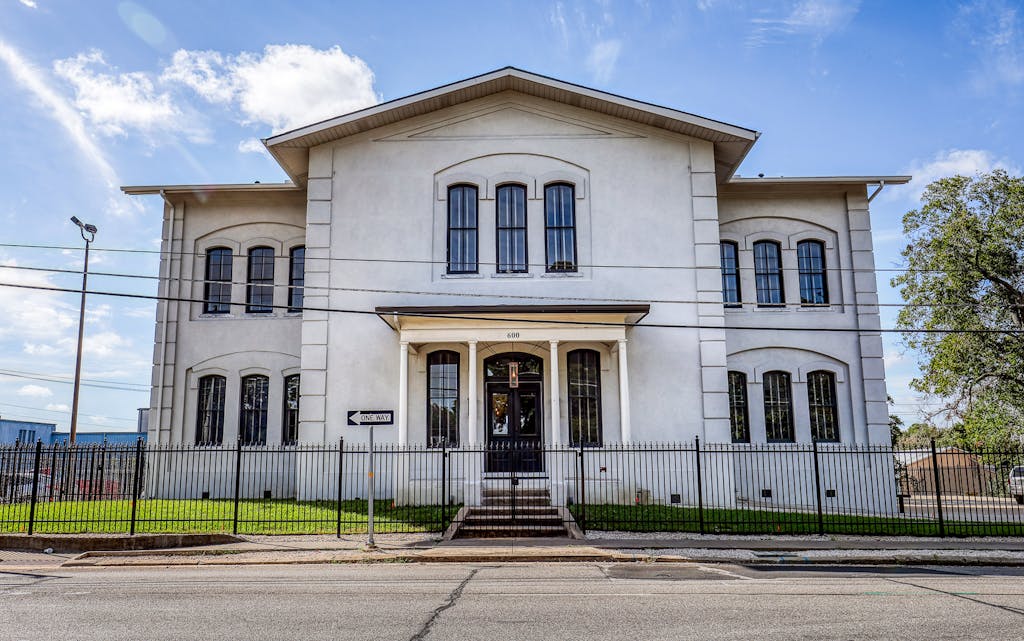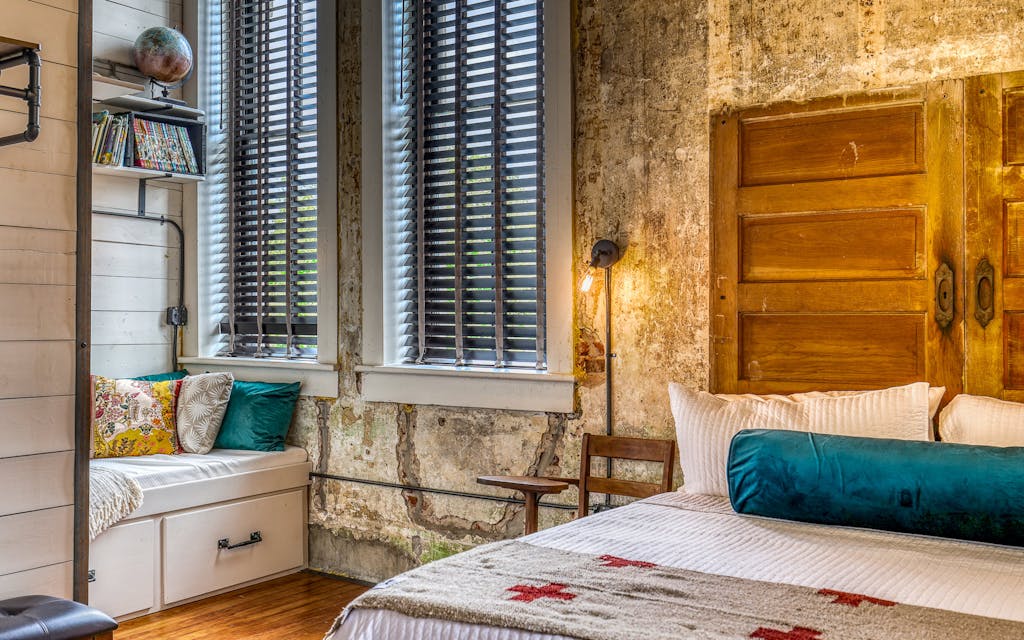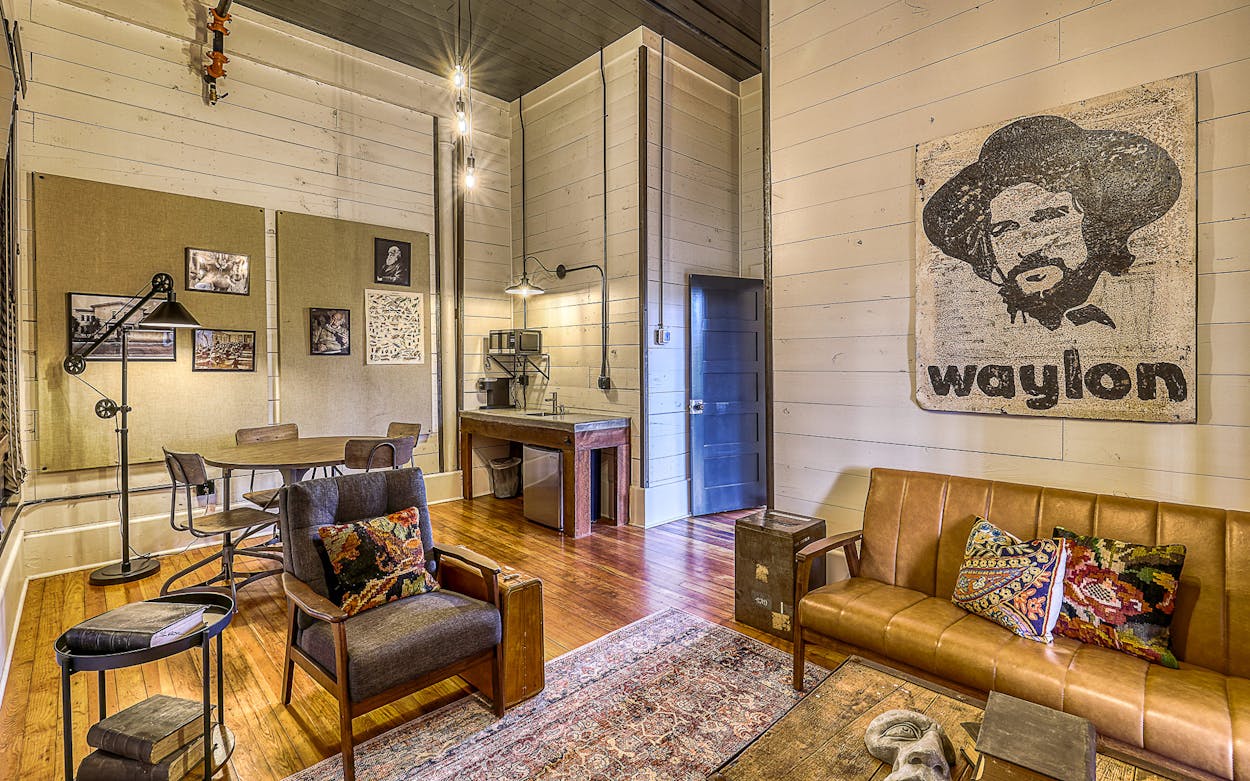The walls of the Brenham Schoolhouse Hotel are so alive with layers and texture, they might actually talk. If so, it would be nice if they could answer some questions. Were the schoolchildren who studied Cicero and German here in 1883 actually attending the first public school in Texas, as some locals claim, or was this just one of the earliest? Did the Dominican nuns from Galveston, sent here in 1909 to start a convent, actually hold mass in the chalkboard-lined classrooms, as one neighbor reported? And who inscribed lines of Alfred, Lord Tennyson’s poetry on the wall in suite three? Walls, we want answers.
When Jake and Meagen Gumm first bought the approximately seven-thousand-square foot Italianate schoolhouse in 2018 and began to pull away the Sheetrock that covered its interior, they discovered surfaces as nuanced as a Rauschenberg painting: the original fifteen-inch-thick brick, dating from 1883; crumbly stucco and plaster; faded wallpaper; shiplap; and even rough black chalkboard that lines the entire perimeter. The Gumms sought to carefully uncover the schoolhouse walls in a way that would highlight the intricate layers, and in so doing, they created a guiding aesthetic for the entire renovation.

“We decided that our goal was to expose,” says Meagen, the executive director of a child advocacy center in Victoria whose only prior renovation experience was the couple’s own home in Goliad, a small town in southeast Texas. “It was all Sheetrock. We didn’t know those chalkboards were going to be there. We wanted to just expose and see where it took us.” Now those walls are the protagonists in the schoolhouse’s new life as a four-suite-and-three-single hotel that will celebrate its official opening on February 16. The couple, who have family in Brenham, saw how the town’s location—halfway between Austin and Houston and twenty-some miles from the popular antiques mecca of Round Top—has made it an increasingly desirable spot for tourists.
On a drizzly January night, I punch in the key code sent to me by the hotel’s management company—the hotel has no staff on-site—and push open the original carved wooden doors to a soaring space with eighteen-foot ceilings and slender iron columns. It’s a dramatic shift from the quiet Brenham street outside. A metal stairwell built with the oak steps from the original stairs makes a bold centerpiece in the lobby. Industrial light fixtures that Meagen sourced in Round Top illuminate the hotel’s smooth original wood floors. The Gumms have successfully merged clean-lined modern upgrades—including exposed HVAC and sprinkler systems—with the Italianate architecture of more than 150 years ago.
The next morning, I spend my first hour lounging in room A with coffee, mesmerized by the walls. Despite an application of sealant, a few small chunks of plaster huddle in the corner, reminding me that, as Jake said, these walls are “living, breathing, and shedding.” The Gumms meet me midmorning, and it’s immediately clear that, in the five-plus years they’ve worked on it, they’ve come to know this building like a family member. Jake, down-to-earth and with the mien of a South Texan Travis Kelce, stands beneath the lobby area’s original cedar beams and slim iron pillars to explain the building’s engineering. With his hands stretching upward, he speaks of joists and load-bearing walls with the enthusiasm of someone who loves a well-built structure.


Although this is the Gumms’ first big renovation, Jake has ample experience coordinating complicated building projects; he worked as a project manager at his family’s South Texas oil field–services company for more than fifteen years. During the Eagle Ford Shale boom, he oversaw heavy equipment—backhoes, dozers, Maintainers—used to build roads and blast rock. Eagle Ford was an all-consuming work period that left him ready for a change. He wanted to be his own general contractor on a worthy renovation project.
When visiting family in Brenham in 2018, the Gumms happened upon the schoolhouse, and Jake found the project he was looking for. “I was rounding this corner,” he says. “We turned and there’s a big old For Sale sign. And this building was looking at you, and, I don’t know, it just jumped out at me.”
And then began the paperwork and the meetings—with the city, the historical society, the architects. The Gumms had to figure out the puzzle of both preserving the history and bringing the building, which hadn’t been in use as a school since 1909, up to code. One wall was crumbling. There was a toilet sitting out in the middle of the main room. No central AC. The woman who sold them the property had been living there. She attempted a renovation, but then gave up and put the building up for sale.
“There were quite a few hoops to jump through that we didn’t count on,” Jake says. “Of course we didn’t. We were unfamiliar. It was about six months of paperwork before we even brought a hammer in here.”

And just as the walls were layered with history, so were other construction elements, like the electrical system. “The first wiring, I imagine from 1883, was just a wire running through the wall—no coating on it,” Jake says. “And then they had some wiring that was done in the early 1900s, and then in the 1970s there was a layer of wiring from when it was an apartment complex. So we pulled all of that out and started from scratch.”
While neighbors dropped in during construction to share stories about the property, the Gumms derived most of the schoolhouse’s history from records of its state historical marker and a hundred-page pdf of lively communication between the Washington County and Texas Historical Commissions when the county applied for the marker in 1969. The letters, legal documents, and articles contained in that pdf confirm that the building was indeed a schoolhouse, where the children studied German and the classics, and became a convent of Dominican Sisters in 1909. But even though the members of the Washington County Historical Commission insisted it was the first public high school in Texas, they could never prove it, and they had to settle for a marker that read, “First free public school in Texas to be set up under landmark school law of 1875.” This wording, however, I had to find on the THC website; the physical historical marker disappeared years ago, and no one seems to know how or why.
While Jake was fully immersed in construction—working with local plumbers, welders, and carpenters and even engaging the Brenham High shop class to build bases for the exterior columns—Meagen worked on interior design. She and her mother, veterans of the Round Top antique markets, plucked school-themed treasures from different locales for room decor—old books from a law office in Cuero (you can see the cursive signature of the former owner on their fore edges), globes and school desks from Round Top, pendant lamps from La Grange. Streamlined leather couches and Turkish textiles from Wellstil add comfort and warmth to the building’s industrial aesthetic.

When the Gumms first bought the schoolhouse, they didn’t expect that the project would take more than five years to complete. In addition to the renovation challenges, COVID came, then Jake almost lost sight in one eye due to an accident while mowing the schoolhouse grounds, then Meagen was diagnosed with breast cancer—all of this in addition to raising two young children. “Life happened,” says Meagen, with the smile of someone disinclined to complain. When I ask them if they would do it again, they both say they are glad they did it, and also glad most of the work is behind them. “But I love the before and after,” says Jake.
Longtime Brenham residents are happy to see one of the town’s historic buildings cared for. “It’s wonderful when people buy an old building and restore it and create a destination for other people to appreciate,” says Allen Jacobs, the City of Brenham official who worked with the Gumms on permitting and other aspects of the project. “It took a long while to accomplish what the Gumms did because it was so well thought-out—they had a vision and they took the time to achieve it.”
Currently, the hotel is operated as a self-check-in property with no food or beverage on-site. A small galley kitchen is located off the main downstairs common area, and single-serve coffeemakers with pods are provided in each room. The local vacation-rental company that manages the property, Koze, has supplied a little guidebook to the area, with plenty of suggestions for cafes, restaurants, bars, and other attractions in Brenham’s quaint downtown and the wider region.
On my tour of the property, the couple lingers upon its many details and idiosyncrasies. We check out the exterior marble sills that frame the building’s original single-pane windows. Tall, narrow, and topped with handsome curved pediments, the windows are a signature feature of the building’s Italianate style. Inside, we stare into the stone-rimmed cistern in the lobby that Jake unearthed during renovation, now covered in three layers of a glass composite he ordered it from a special construction company in California; it is one of dozens of private and public cisterns discovered in Brenham over the last few decades. In one suite, a.k.a. the Burn Room, we observe the charred walls left by a fire that broke out here, likely made by the squatters who once called the building home. The Gumms kept the burns intact and hung a portrait of Johnny Cash on the wall, a poetic nod to that once literal ring of fire. In suite three, Meagen and I try to make out the cursive letters inscribed on fragments of wallpaper, but Jake knows Tennyson’s words by heart: “Better not be at all than not be noble.” These walls are talking, and they want us to be good.
- More About:
- Style & Design
- Hotels
- Brenham






